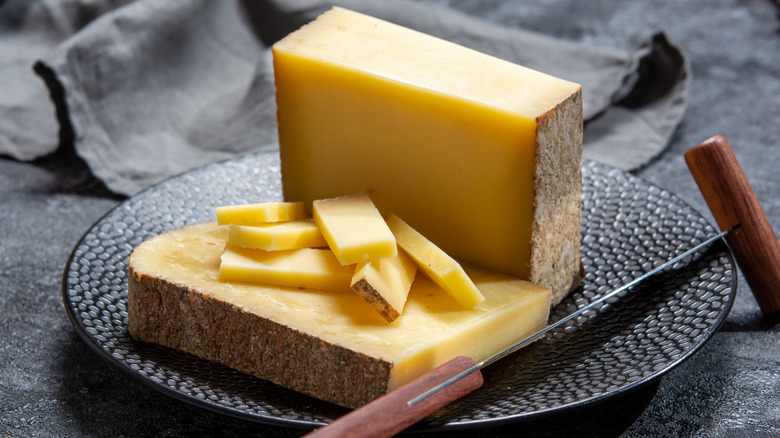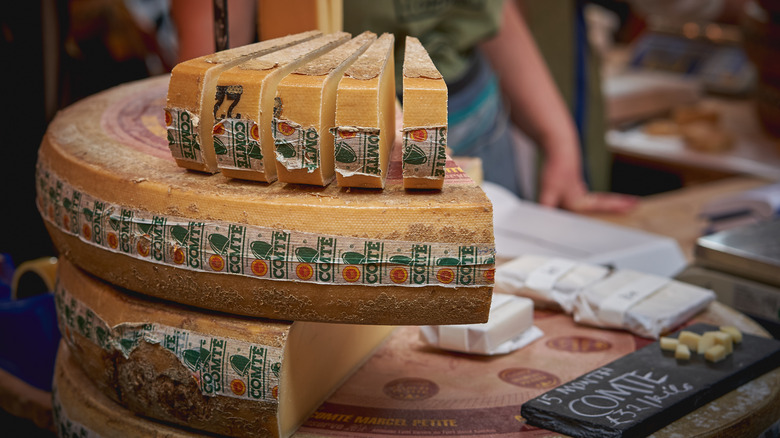What Makes Comté Cheese Unique
Comté is "the little black dress of cheeses," according to The Cheese Professor, as it can pair with both red and white wines and even some beers, as well as be included in cooked dishes and served on cheese boards. "Fruity, nutty, salty, smoky, and sweet," the light yellow cheese is one of the world's best and most nuanced, according to Cheese.com. With a texture that can range from silky and smooth to rock-like, Comté can make a variety of meals complete.
One of the aspects that makes Comté cheese appealing is its association with the particular place it's made as well as the way in which it is made, notes The Cheese Professor. This cheese can't be made anywhere or with milk from any kind of cow; Comté is known for its unique smell and taste that is particularly associated with cows in the mountainous regions of eastern France.
Where Comté comes from
Comté cheese is made along the French and Swiss border and is labeled a PDO product, which designates food products that are made in a specific region in a regulated way, per The Cheese Professor. In the case of Comté cheese, the milk from Montbeliarde or French Simmental cows must be used, and the cows must be milked close to production factories so that the milk arrives as fresh as possible to begin the cheese-making process. Only about 150 sites make this cheese, and copper vats are used to heat the milk.
Castello Cheese adds that when prepared, Comté cheese wheels are lined with curd and pressed to squeeze out any remaining whey before a mixture of sea salt and yeast is painted along the rind. At this stage, the cheese is ready to age in caves where it's left to ripen anywhere from four months to two years, notes Cheese.com.
How Comté tastes
The aging of Comté chese is finicky business, notes The Cheese Professor, as the aging process dramatically impacts the taste of the cheese. At around four months, Comté cheese is soft, supple, and nutty, but over time, the cheese hardens and becomes more nuanced in flavor with notes of celery, nutmeg, dried pineapple, and even baked macaroni and cheese. Talk about a range in taste.
Castello Cheese describes these unique cheeses as something like an outdoor adventure: salty and sweet, with the ability to transport cheese aficionados across forests and countrysides to crackling fires where roasted hazelnuts and caramelized butter await. Cheese.com estimates there are around 83 flavors associated with Comté, but brown butter and roasted nuts are the flavors that are most easily detected. This is a complex, versatile cheese, and with so many variables, it's worth trying a variety of Comté cheese to see which flavors suit your palate.
How to enjoy Comté
Slice Comté and pair with roasted garlic, toasted hazelnuts, cured meats, and a few rosemary sprigs for an unbeatable, Instagrammable cheese board, recommends Di Bruno Brothers, or enjoy Comté on a fresh baguette with a spoonful of apricot butter for an afternoon snack. Alternately, serve Comté with a dry amontillado sherry for dessert, or consider pairing the cheese with Chardonnay or a Chenin Blanc, advises Slow Wine. Because this cheese is so versatile, it can also be served with glasses of Pinot Noir, Beaujolais, Rioja, and red Bordeaux.
If you're making a fondue, Comté melts easily, notes Cheese.com, particularly the younger varieties. Maleducat encourages home chefs to combine the cheese with others like Gruyere or Emmenthaler and consider adding the cheese to eggs, quiche, and sandwiches. While older Comté doesn't melt as easily, it can be grated over soups or on top of vegetables, or simply sliced and served at room temperature alongside crackers or toast. After one bite, you, too, may be riding the Comté train.



